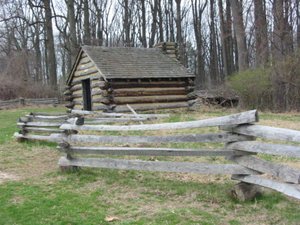Advertisement

 Reconstructed Hut
Reconstructed Hut
Reconstructed Conway Hut on the Inner Line Defenses, Valley Forge National Historical Park. The Continental Army spent the winter of 1777-1778 encamped at Valley Forge.
National Historic Landmark. National Register of Historic Places 66000657. IMG_0628Valley Forge, Pennsylvania, was the winter encampment for George Washington and the Continental Army in 1777-1778. The name itself conjures up a sense of cold, privation, and sacrifice in American thought.
We drove out from Philadelphia to see the Valley Forge National Historical Park. The park is located near King of Prussia, Pennsylvania. The major landmark here is the very large King of Prussia Mall. You see it from the highway as you make the turnoff for Valley Forge park. Even so, at Valley Forge today one can still get a sense of the terrain and the size and layout of the site as it was during the Revolutionary War. The park has been very well preserved, though it is located near a large Philadelphia suburb. The visitor center has exhibits and shows a film about Valley Forge and the experiences of the winter encampment. The 12,000 diverse troops (including many African-Americans and Native Americans) dug in for the winter by constructing log huts and did their best to forage for food and stave off illness. After seeing the visitor center exhibits, we set off on the driving tour. (The park can also explored via hiking trails.) The driving tour

 Washington's Headquarters at Valley Forge
Washington's Headquarters at Valley Forge
George Washington's Headquarters at Valley Forge, Stone farmhouse also known as the Isaac Potts House, built about 1758. Washington occupied the house from 24 December 1777 to 18 June 1778. Valley Forge National Historical Park.
National Register of Historic Places 73001655
National Historic Landmark. National Register of Historic Places 66000657. IMG_0630through the large park leads one to the significant sites, including reconstructed log huts, defensive lines, and the stone farmhouse where Washington made his headquarters. The National Memorial Arch dates from 1917.
The British Army battled the Continental Army through the Schuylkill Valley of Pennsylvania during the summer and fall of 1777. The British, already in possession of New York City, captured Philadelphia, then the largest city in North America, in October, 1777. George Washington brought the Continental Army to this site as a defensible position some distance from Philadelphia. The Continentals arrived 19 December 1777. Huts were built to house the troops and the American army, short on supplies, prepared to wait out the winter. By spring, Prussian Baron von Steuben had come to help drill the American troops at Valley Forge and form them into a professional army.
Advertisement
Tot: 0.125s; Tpl: 0.015s; cc: 13; qc: 30; dbt: 0.086s; 1; m:domysql w:travelblog (10.17.0.13); sld: 1;
; mem: 1.1mb

 Reconstructed Hut
Reconstructed Hut
 Washington's Headquarters at Valley Forge
Washington's Headquarters at Valley Forge




